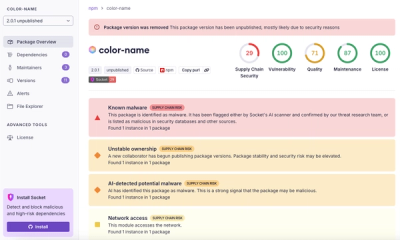
Research
/Security News
npm Author Qix Compromised via Phishing Email in Major Supply Chain Attack
npm author Qix’s account was compromised, with malicious versions of popular packages like chalk-template, color-convert, and strip-ansi published.
github.com/GoogleCloudPlatform/cloud-builders/gcs-fetcher
** Warning: This builder is experimental and is very likely to change in breaking ways at this time. **
This tool fetches objects from Google Cloud Storage, either in the form of a .zip archive, or based on the contents of a source manifest file.
A source manifest is a JSON object in Cloud Storage listing other objects in Cloud Storage that should be fetched. The format of the manifest is a mapping of destination file path to the location in Cloud Storage where the file's contents can be found.
The following is an example source manifest:
{
"Dockerfile": {
"sourceUrl": "gs://my-bucket/abcdef",
"sha1sum": "<sha-1 digest>"
},
"path/to/main.go": {
"sourceUrl": "gs://my-bucket/ghijk",
"sha1sum": "<sha-1 digest>"
}
}
To process the above manifest, the GCS Fetcher tool processes each element:
sourceUrlSo in the above example, the tool fetches gs://my-bucket/abcdef, verifies its
SHA-1 digest, and places the file in the working directory named as
Dockerfile. It then fetches gs://my-bucket/ghijk, verifies its SHA-1 digest,
and places the file in the working directory at path/to/main.go.
The main benefit to source manifests are in enabling incremental upload of sources from a client.
If a user uploads the two files in the example above, then edits the contents of
their Dockerfile, only that new file has to be uploaded to Cloud Storage, and
the manifest for the next build can reuse the entry for path/to/main.go,
only writing a new entry for Dockerfile to specify the new file's location in
Cloud Storage.
In the case of a file move, where file contents don't change, no new files have to be uploaded. The new manifest simply changes the key in the object describing the path to place the file fetched from Cloud Storage.
To fetch source described in a source manifest, add the following line to your build config:
steps:
- name: 'gcr.io/cloud-builders/gcs-fetcher'
args:
- '--type=Manifest'
- '--location=gs://${PROJECT_ID}_cloudbuild/manifest-foo.json'
It may also be useful to produce and upload source manifests describing some
source, which you can do with gcr.io/cloud-builders/gcs-uploader:
steps:
- name: 'gcr.io/cloud-builders/gcs-uploader'
args: ['--location=${PROJECT_ID}_cloudbuild/manifest-${BUILD_ID}.json']
This will upload the contents of the workspace directory, ignoring objects that
are already present in Cloud Storage, and upload a manifest JSON object named
manifest-${BUILD_ID}.json to the same Cloud Storage bucket.
gcs-uploader will not delete remote objects that are not present locally.
gcs-fetcher and gcs-uploader can be used together to provide simple
cross-build caching functionality, by optimistically fetching files that are
expensive to generate at the beginning of the build, and by uploading those
files at the end of the build.
In order to benefit from this you would need to define a well-known reusable manifest file location.
steps:
# Attempt to fetch whatever files are available.
- name: 'gcr.io/cloud-builders/gcs-fetcher'
args:
- '--type=Manifest'
- '--location=gs://${PROJECT_ID}_cloudbuild_cache/manifest-foo.json'
# Generate new files, ignoring those that already exist.
# - name: 'generate-new-files'
# ...
# Upload all files; only new and changed files will be uploaded to
# Cloud Storage.
- name: 'gcr.io/cloud-builders/gcs-uploader'
- '--bucket=${PROJECT_ID}_cloudbuild_cache'
- '--manifest_file=manifest-foo.json'
Tips and Caveats
${BRANCH_NAME} or some other unique value in the manifest file
location to avoid this.FAQs
Unknown package
Did you know?

Socket for GitHub automatically highlights issues in each pull request and monitors the health of all your open source dependencies. Discover the contents of your packages and block harmful activity before you install or update your dependencies.

Research
/Security News
npm author Qix’s account was compromised, with malicious versions of popular packages like chalk-template, color-convert, and strip-ansi published.

Research
Four npm packages disguised as cryptographic tools steal developer credentials and send them to attacker-controlled Telegram infrastructure.

Security News
Ruby maintainers from Bundler and rbenv teams are building rv to bring Python uv's speed and unified tooling approach to Ruby development.